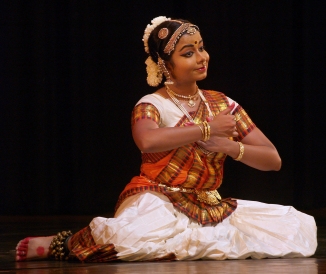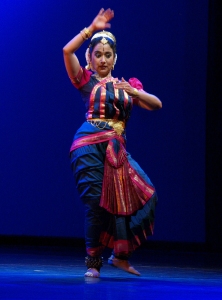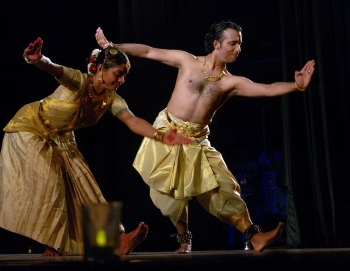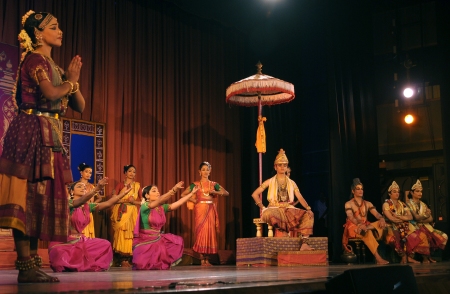
|   |

|   |
The Music Academy Dance Fest: Day 2 - Veejay Sai e-mail: vs.veejaysai@gmail.com Photos: Thanthoni January 8, 2012 The Kashta Nayikas and Persian Griffin The second day of the Academy’s dance festival opened with a solo recital by Madhavi Chandran, a student of the Dhananjayans. Pleasantly plump Madhavi looked like she could be presenting a Mohiniattam performance, thanks to her ballooning costume.  Madhavi Chandran She opened her performance with a Mallari and an Alarippu, both in Khandam. Madhavi’s show was utmost average to begin a whole day’s programs with. Except for Guru Shanta Dhananjayan’s brilliant nattuvangam, there wasn’t much to write home about. The second performance was Uma Murali presenting Kuchipudi.  Uma Murali Uma started her performance with an invocation to Lord Ganesha. Choreographing the popular Ganesha Pancharatnam written by Adi Shankara, Uma’s show was full of promise. Half way through the invocation, all one could see was bright flashy lights being thrown on the cyclorama at the back of the stage. These lights drowned Uma and her dance for the rest of her performance. Just because there is a cyclorama available, does it mean one would use it this way? Effective lighting design is not everyone’s cup of tea. She continued her performance and did ‘Ashtavidha Nayika’ composed by Madurai Muralidharan set to a ragamalika. What is the need to reel out basic data on what each nayika is? One wondered if it was some lec-dem or supposedly the most prestigious dance festival of the Margazhi season, where knowledgeable rasikas come to view performances. Wading herself through each of the eight nayikas, one couldn’t help but sigh in exasperation. The Ashta Nayikas were turning out to be more difficult than a bunch of undecided women who go grocery shopping. Uma moved on to perform Oothukadu’s famous ‘Kalinganartanam’ thillana. By then the mood of the sabha was already low on energy. She concluded with a ‘Simhanandini.’ It is a dancer’s dream to perform on a stage like the Academy’s with so much space like none other in town, especially for an item like ‘Simhanandini’ where the dancer makes efficient usage of the stage space and elaborate on detail using their artistic expertise. Uma decided she would limit herself to a corner of the stage. With a camera relaying her footwork on the cyclorama behind to the audiences, what emerged on screen was a weird cross between a Persian cat and a griffin with stunted legs, which could have walked straight out of ‘Lord of the Rings.’ It was easier to concentrate on Sruthi Sagar’s brilliant flute accompaniment than see the genesis of this weird creature that Uma created. What a way to end the morning! Burnished Gold  Srividya Natarajan and Hari Krishnan
Rasikas waited in eager anticipation for the evening show as they were
welcomed with small diyas lit on the stage. This is the second time this
season one is getting to watch a stage set created by Rex. First was
the brilliant visual design he created for Anita Ratnam’s ‘Andal Andal’ a
couple of weeks ago at the inaugural of the ‘Mad & Divine’
conference. Going by his aesthetic sense of what the theme of a
production needs, one can easily say Rex is the best this season has
witnessed. Those of you interested in how to create innovative visual
designs for your dance programs, head straight to Rex and trust him to
pop up some of the best ideas. Now for the performance. Titled ‘Gold’ as an offering to their Guru Kitappa Pillai, Toronto based dancer choreographer Hari Krishnan collaborated with Srividya Natarajan and performed as a duo on the second evening of the festival. They announced that their performance was dedicated to the Devadasis and to celebrate the bicentenary of Thanjavur Vadivelu. Notable items presented were the Rudraganika Kavuttuvam in Vasanta Ragam composed by Tirugokarnam Ramasvami Nattuvanar and the varnam Sarojakshiro in Kedaram composed by Vadivelu himself. There are very few dancers who are also well-grounded in the academics of the art form and Hari and Srividya are probably some of the best examples of that genre. Solid in their research on the history of the items they were presenting, perfect in choreography all the dance lovers in the audience had to do was sit back and enjoy a superb show. Rex’s minimalistic stage set with the little diyas around the stage made the space breathe the vibes of an ancient temple. Using smart light design (by Victor Paulraj) enhanced the aesthetic quality of the production. Srividya presented a joyful solo javali ‘Oho ho Sundaruda’ set to Bilahari Ragam written and composed by ‘Narayana Dasa’- a javalikarta of Jagannadhapuram from the west Godavari district of Andhra Pradesh. Seeing her performance, one couldn’t help wondering what was a fantastic dancer like Srividya doing so far off in another country when she could take the entire Indian dance scene by storm! India’s loss is Canada’s gain and we hope she visits us as many times as possible to let rasikas here enjoy good undiluted dance. The duo concluded their performance with a Thillana composed by Thanjavur Ponnaiya. One couldn’t help but flip through the Music Academy’s festival brochure and under the credits were the names of Dr. B.M. Sundaram and Dr. Davesh Soneji who helped the dancer-duo with the research material for this show. With such eminent scholars collaborating to put this production together, what the dancers called ‘Gold’ transformed itself into pure high quality platinum by the time it reached the rasikas across the stage. What better tribute to the Tanjore Quartet! Remembering Mysore Vasudevacharya and the Kalakshetra Movement  ‘Sita Swayamvaram’
The second show for the evening was a drastic drift from the first. ‘Sita Swayamvaram’, a classic Kalakshetra production choreographed by its founder Rukmini Devi Arundale with soulful music composed by the legendary Mysore Vasudevacharya changed the mood of the hall. While the dance-drama did feel like a student production, what one must credit is the acting of several dancers, the muted earthy tones of the costumes and the music. The dance-drama presented in three scenes starts in the court of King Dasharatha and concludes with the actual act of the Swayamvaram. Sheejith Krishna’s role as Ravana and Indu Mohan as Sita couldn’t have been more perfect for this production while many other characters seemed like they desperately needed better casting. The production also looked like it was edited from the original which Rukmini Devi might have choreographed. Audiences sat spellbound with the original music score composed by the legendary vidwan. A quick glimpse around the hall and one could see many rasikas trying to lip-sync the lyrics and familiar tunes. Good music is good music and has that eternal quality of coming alive, every time it is sung. The evening clearly belonged to Hari and Srividya for their dazzling performance. Veejay Sai is a writer, editor and a culture critic. |